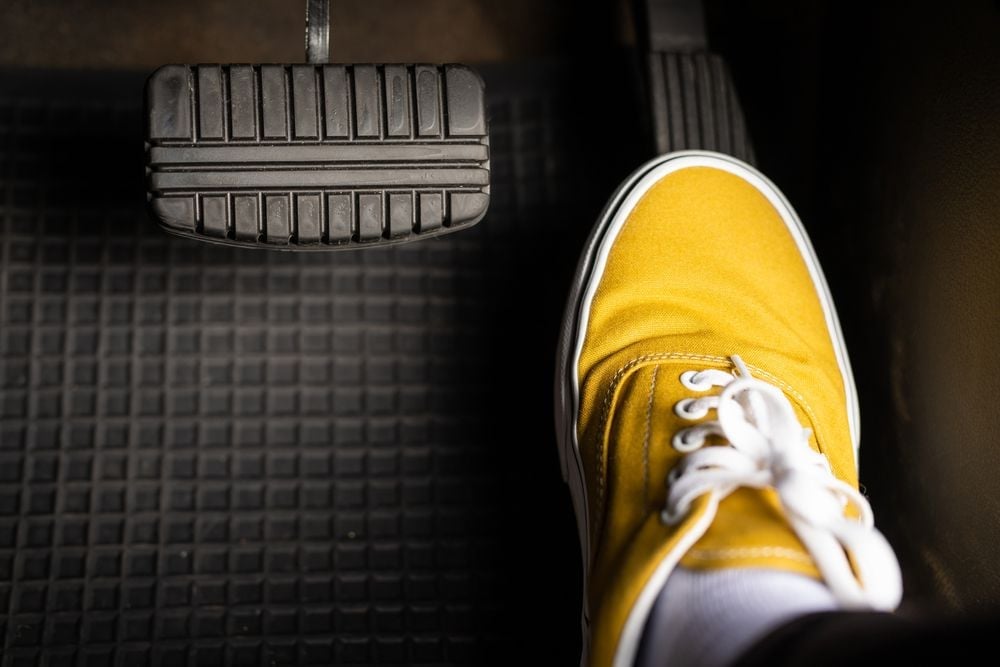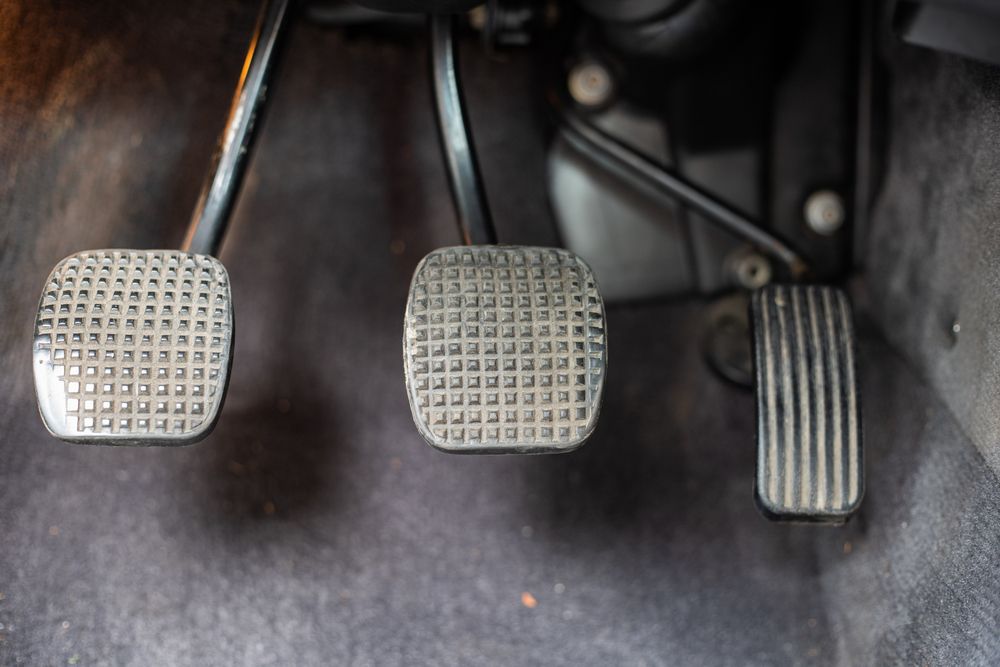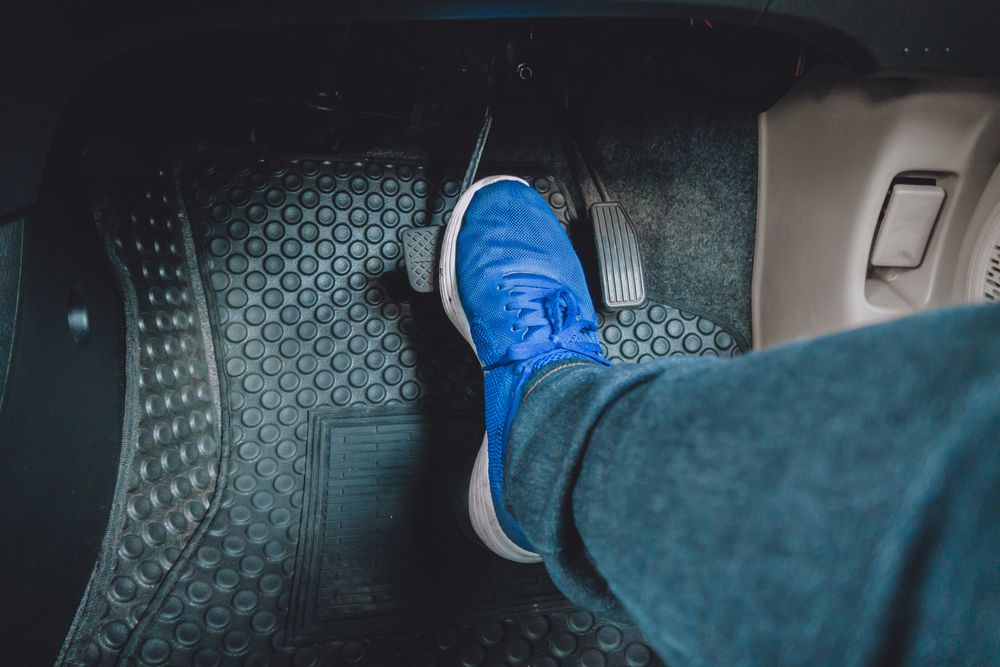
If you're confused about whether the gas pedal is on the left or right, you
aren't alone.
The answer to your "is the gas pedal on the left or right" question is
simple — it's always the right-most, skinnier pedal.
No matter which country you are driving in, the transmission type, or
its configuration, you can count on the gas pedal always being on the
right, followed by the brake pedal on the left.
In the following sections, we'll explore the position of vehicles' pedals
according to country, the type of transmission, and more.
 Gas pedal is on the right.
Gas pedal is on the right.
Is The Gas Pedal On The Left Or Right In America?
Confusion surrounding whether the gas pedal is on the left or right side in
different countries is understandable since the steering wheel changes
position.
However, the gas pedal is always on the right side in America (or any other
country, for that matter), regardless of whether the car is a right-hand
drive or left-hand drive.
Whether you're driving left-hand drive vehicles or even a tank, you can
rest easy knowing the gas pedal is always on the right.
In a manual transmission car, the accelerator pedal is on the right, the
brake pedal is in the middle, and the clutch pedal is on the left side.
A good way to remember this is by thinking of "ABC" or "Accelerator, Brake,
Clutch" from right to left.
If you drive an automatic transmission, the gas pedal is still on the
right; the brake pedal just takes up the center and left spots (i.e., there
are two pedals instead of three).
Think about it from the perspective of how you utilize the foot pedals.
You always use your right foot to work the gas and brake pedal since
they're on the right, while you use the clutch pedal with your left foot
since it's on the left-hand side.
Is The Gas Pedal Lower Than The Brake Pedal?
Depending on your car, the gas pedal might sit lower than the brake.
Here are the two potential reasons for this:
-
When the car's accelerator is lower, your right foot cannot
accidentally slip and hit the brakes.
-
You'll spend most of your time keeping your foot on the gas pedal, so a
lower position gives you more control and comfort over the car's speed.
Why Is The Gas Pedal Important?
The accelerator pedal is important because it controls your car's RPM,
allowing you to stick to the speed limit.
The more the crankshaft rotates, the more power the transmission can
transfer to the wheels, pushing it forward.
 Left to right: clutch, brake and gas pedals.
Left to right: clutch, brake and gas pedals.
An Overview Of Modern Cars' Foot Pedals
You'll find three pedals in a car with a manual transmission:
-
Gas pedal
-
Brake pedal
-
Clutch pedal
In an automatic vehicle, you don't have a clutch.
In some cars, you'll find a pedal that controls the parking brake.
However, that's always far enough away from the other pedals, so you don't
accidentally engage it while on the road.
Best And Safest Practice: Never Drive With Two Feet
While it isn't illegal to drive a car with two feet, only pushing the gas
and brake pedal with your right foot and leaving your left foot for the
clutch pedal (or nothing in an automatic) is the safest method.
Driving with both feet has proven to be unsafe, contributing to more
accidents for several reasons, including:
-
It's easier to get confused about which pedal your left foot should be
stepping on at which time.
-
You could inadvertently ride the brake while accelerating, causing
vehicle damage and confusion for other road users.
So, stick to using the correct feet for the correct pedals.
Is The Gas Pedal On The Left Or Right In Europe?
The United States of America is a left-hand-drive country.
However, there are countries in Europe that use right-hand-drive cars.
In these vehicles, the steering wheel shaft is where Americans expect to
see the front passenger seat.
Even so, the pedals stay in the same place, meaning the gas pedal is on the
right.
The only changes are things like hand-operated high beams and the gearbox
compartment.
Due to the switch in hand positioning, many Americans find it tricky
driving a manual car in England, but using an automatic is the same.
What Side Is The Gas Pedal On In A Right-Hand Drive Car?
No matter the car's configuration (i.e., left- or right-drive) or
transmission type the gas pedal is always the right-most foot pedal.
Your feet do the same thing when driving in right-hand-drive countries;
it's your hands that have to switch jobs.
 Foot on the brake pedal.
Foot on the brake pedal.
Is The Brake On The Left Or Right?
You've probably assumed that because the gas pedal stays on the same side,
the brake pedal follows suit — and you're correct!
Regardless of the transmission or which side of the vehicle the driver sits
on, you can always find the brakes on the left.
In a manual car, the brake pedal is in the middle because the leftmost spot
is taken up by the clutch pedal.
You apply the clutch with your left foot and use your right leg for the
brake and gas pedals.
Why Is The Clutch Pedal So Important?
You use the clutch to change to the next gear.
Without it, manual transmission cars could never disengage (and thus,
change) gears.
Is The Brake On The Left Or Right In An Automatic Car?
The brake pedal is the leftmost pedal in an automatic vehicle because there
isn't a clutch.
It takes up the left and center positions, meaning it's substantially
bigger than the accelerator.
What Side Is The Gas Pedal Found In An Electric Car?
Many people are confused as to whether electric cars even have a gas pedal
— they don't use gas, after all.
But since the proper name for the gas pedal is "accelerator," it really has
nothing to do with how the vehicle is powered.
Like traditionally fueled cars, you can find the gas pedal on the right in
electric vehicles.
The accelerator functions in the same way, too (i.e., it controls the
speed); however, it has a unique feature in EVs called "regenerative
braking."
What Is Regenerative Braking?
It's a feature that some experts say could render the brake pedal
unnecessary!
Essentially, regenerative braking reduces the car's speed and begins
braking as you lift your right foot off the accelerator, saving power and
making driving in heavy traffic less of a nuisance.
That said, we think it's a while before the brake pedal will genuinely be
obsolete in electric vehicles or otherwise!
Conclusion
You can find the gas pedal on the right side of all cars, whether they
boast a left-drive configuration or not.
In manual vehicles, the brake sits next to the accelerator, and the clutch
is the leftmost foot pedal.
But if you have an automatic car, there isn't a clutch, so the brake takes
up the center and right spaces.
Depending on your vehicle, there may be a fourth pedal (or button) that
operates the parking brake when touched with your left foot.
However, manufacturers place this well away from the other pedals to reduce
the likelihood of accidentally touching it while you're traveling down the
highway.